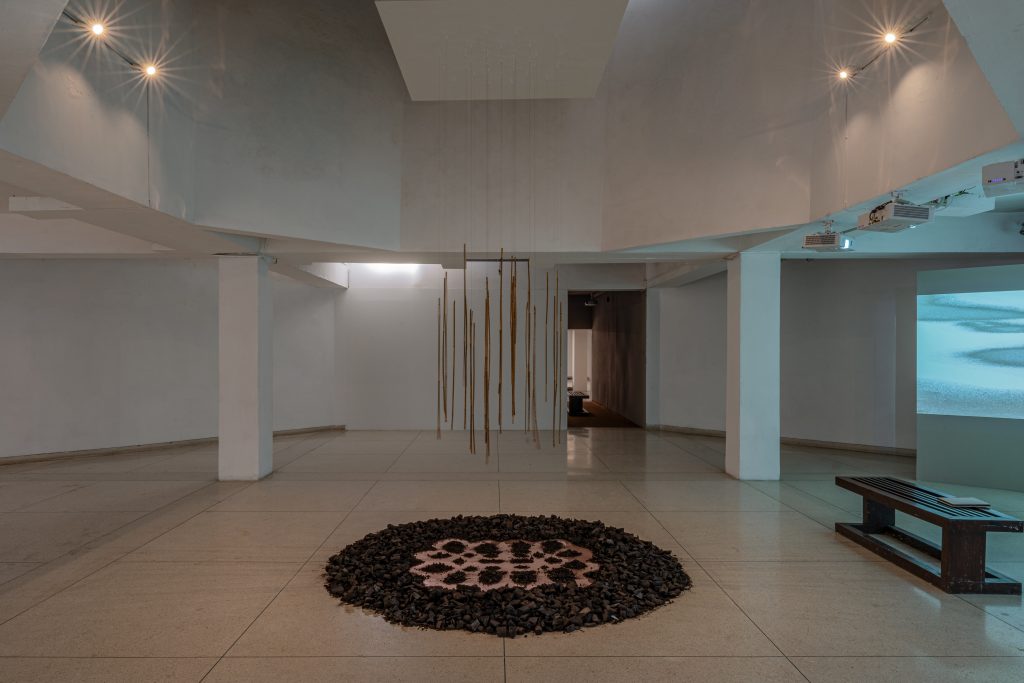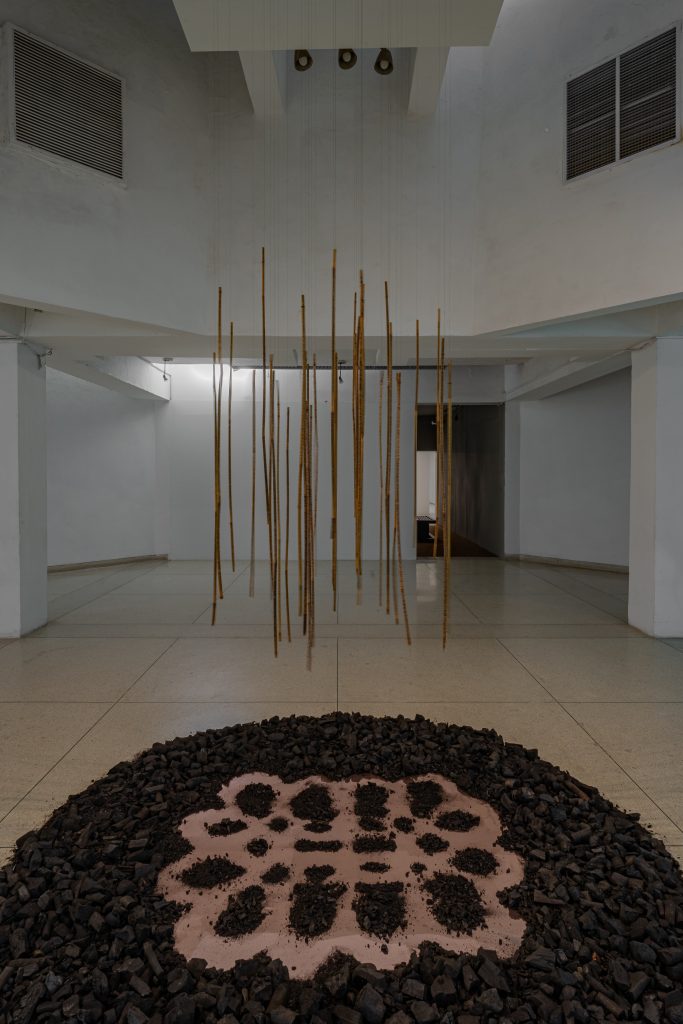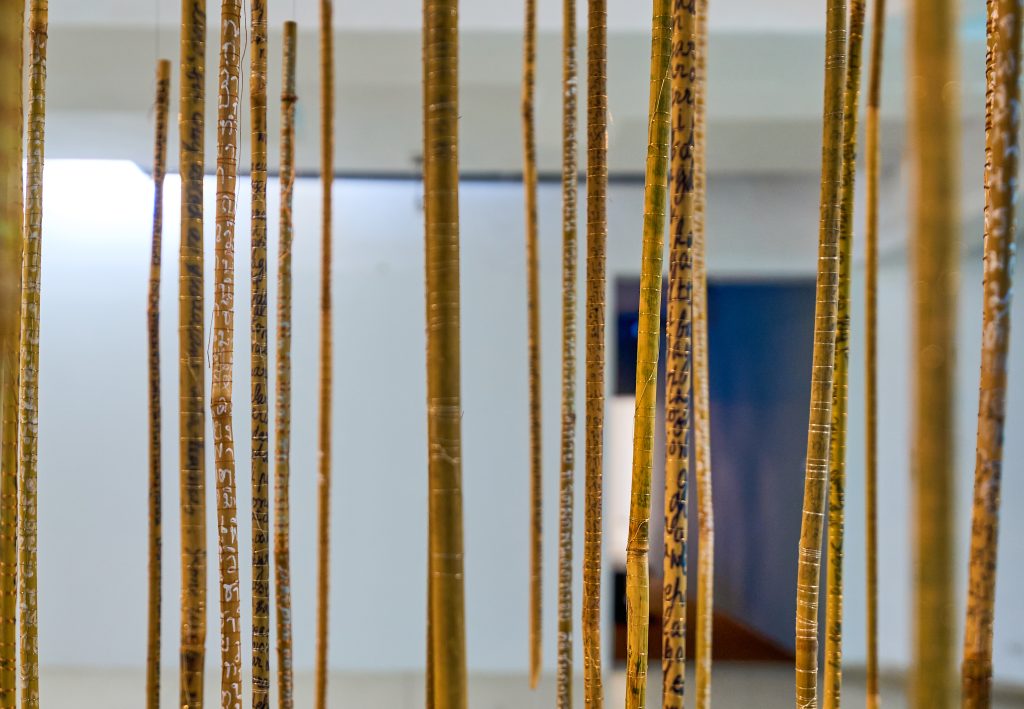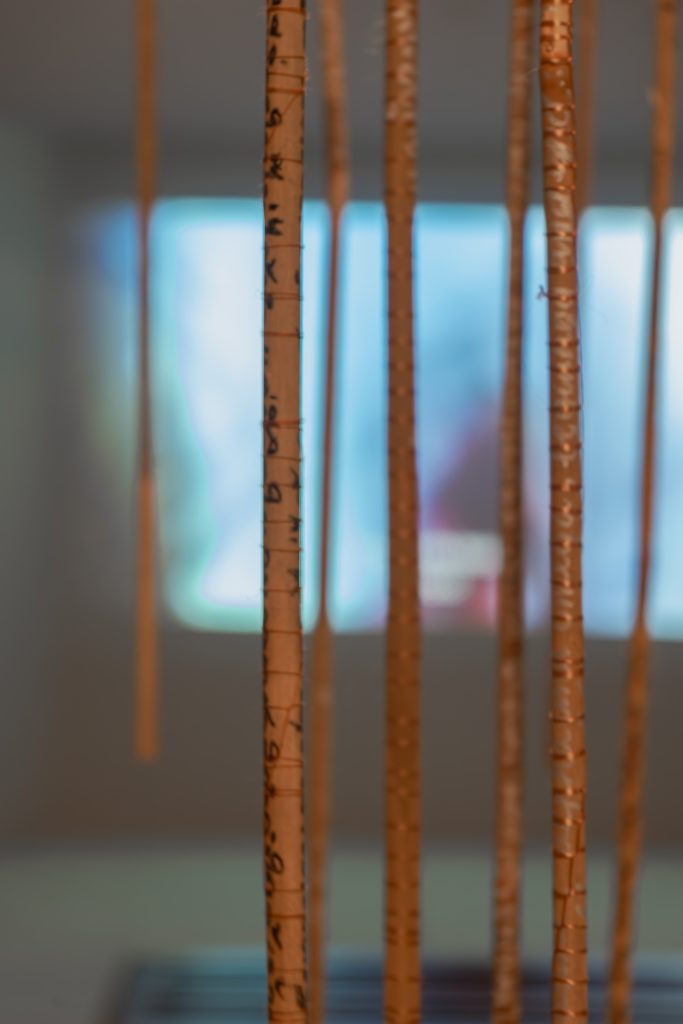Phaptawan Suwannakudt
The Bamboo Tales, Stories of Encounters, 2021
Installation with ink on bamboo, charcoal, mirrored panel
Dimension variable
In Bamboo Tale: Stories of Encounters, Phaptawan Suwannakudt weaves together her life in Thailand and Australia, and ancestral and geological time. On the ground, a round mirror pane covered with charcoal invokes the Dyarubbin River, also known as the Hawkesbury, in New South Wales, which witnessed devastations of bushfires in 2019 and flooding in 2021. Hollowed out from the heap of burnt wood are the recursive curves of a mandala, signifying the infinite cycles of life, also used in Northern Thailand as a protective amulet. Meanwhile, fine bamboo poles bound with silk thread float over the pattern, bearing the names of plants from the two countries, as well as a number of Indigenous names for places along the Dyarubbin. Through these elements, the artist conjures her grandparents, a weaver and a herbalist-sorcerer, as part of samsara, the infinite cycle of life, while casting her own healing spell for the future.
Suwannakudt also has a contribution to Womanifesto’s Procreation/Postcreation on view at the YMCA.
Phaptawan Suwannakudt (b. 1959, Bangkok), trained in Buddhist mural painting in the workshop of her father, well-known artist Paiboon Suwannakudt. In 1995, she took part in the landmark Tradisexion exhibition at Concrete House (1995), which featured a number of Thai women artists, and subsequently with Nitaya Ueareeworakul and other participating artists, founded the Womanifesto project. She emigrated the following year to Sydney, and her work has been exhibited at Cultural Center of the Philippines, Manila (1998), 4A Center for Contemporary Asian Arts, Sydney (2005), the Jakarta Biennale (2021), and documenta fifteen, Kassel (2022).
فاپتہ وان سوانکُدت
‘دی بمبو ٹیلز’، 2021
انسٹالیشن: بانس پر سیاہی، چارکول، اور عکاس پینل
مختلف جہات
سوانکُدت “دی بمبو ٹیلز”پاکستان میں پہلی بار نمائش کے لیے پیش کر رہی ہیں، جو ایک مکسڈ میڈیا انسٹالیشن ہے۔ اس میں بانس کی چند لاٹھیاں عمودی طور پر ایک چمکدار سطح کے اوپر معلق ہیں، جو تاریک مٹی سے گھری ہوئی ہے۔ ان بانس کی لاٹھیوں پر آرٹسٹ کے سڈنی والے گھر کے پچھواڑے میں اگنے والے پودوں کے نام اور دھرم کی تعلیمات نقش ہیں۔ یہ تعلیمات رومن رسم الخط میں انگلش، فرسٹ نیشن کی زبان گفتار (گریس کارسکنز کی کتاب ‘پیپل آف دی ریورز’ سے لی گئی) اور تھائی رسم الخط میں لکھی گئی ہیں۔ یہ بانس کی لاٹھیاں بے شمار ناموں، زبانوں اور کہانیوں کو سموئے ہوئے ہیں، اور زندگی کے دائرے کی علامت پر معلق ہیں، جو شمالی تھائی لینڈ کے لانا لوگوں کی ایک روایتی علامت ہے، جن سے فنکارہ کا تعلق ہے۔ سوانکُدت نے اپنے خاندان کے افراد کی وفات، کووڈ کی پابندیاں، آسٹریلیا میں آنے والی جنگلاتی آگ اور سیلاب، اوران کے بعد دوبارہ نمو پانے والی فطرت کو انسانی زندگی کے دائرے سے جوڑا ہے۔ ان کے نزدیک یہ سب ہماری دنیا کا ایک حصہ ہیں—لانا کی لامتناہی زندگی کی لکیریں جو دکھ، موت، اور دوبارہ جنم کے چکر، یعنی سامسارا، کی تشکیل کرتی ہیں۔۔
فاپتہ وان سوانکُدت 1959 میں بنکاک، تھائی لینڈ میں پیدا ہوئیں اور اب سڈنی، آسٹریلیا میں مقیم ہیں۔ سوانکُدت ایک بین العلاقائی فنکارہ ہیں جن کے کام بدھ مت، خواتین کے مسائل اور ثقافتی مکالمے سے متاثرہیں۔ انہوں نے اپنے فن کا آغاز تھائی دیواری نقاشی سے کیا اور(1970-1981) میں اپنے والد پائِبون سوانکُدت کے زیرِ سایہ تربیت حاصل کی ۔ بعد میں (1984-1986) انہوں نے دیوار نقاش مصوروں کے ایک گروپ کی قیادت کی جس کا نام “تان کُدت گروپ” تھا ۔ وہ خواتین کی گروپ نمائش “ٹریڈِسیکشَن”میں بھی شامل تھیں جو 1995 میں “کانکریٹ ہاؤس” میں منعقد ہوئی اور بعد میں 1997 میں تھائی لینڈ میں قائم ہونے والی خواتین کی بین الاقوامی تنظیم “وومنِفیسٹو” کی پیش رو تھی۔
“ایل بی 03 میں، سوانکُدت اپنی تخلیق ‘وی مینڈ اینڈ پروکریئیشن، (We Mend and Procreation) پوسٹ کریئیشن’ بھی پیش کریں گی، جو انہوں نے وومنِفیسٹو کی دیگر اراکین، نیتایا اور ورشا نائر کے ساتھ مل کر تخلیق کی ہے۔
Supported by Creative Australia
In LB03, Suwannakudt also presented We Mend and Procreation, Postcreation in collaboration with other members of Womanifesto, Nitaya and Varsha Nair.





